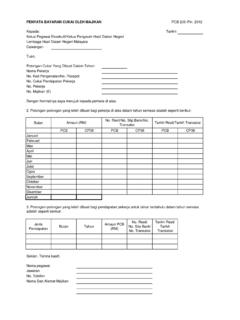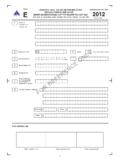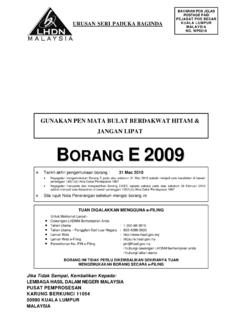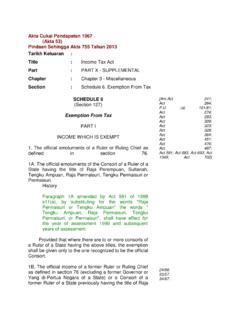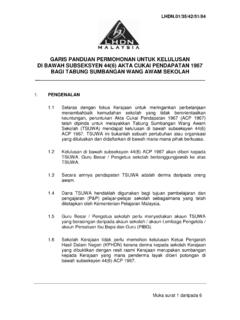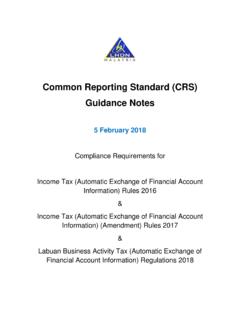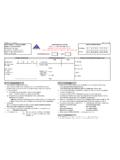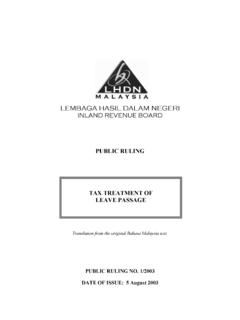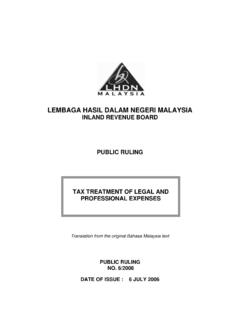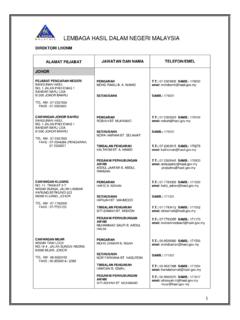Transcription of ADVANCE PRICING ARRANGEMENT GUIDELINES
1 ADVANCE PRICING ARRANGEMENT GUIDELINES 2012 The GUIDELINES , prepared by the Inland Revenue Board of Malaysia, Multinational Tax Department are to help explain procedural and administrative requirements of Section 138C of the Income Tax Act 1967 and the Income Tax ( ADVANCE PRICING ARRANGEMENT ) Rules 2012 . IRBM ADVANCE PRICING ARRANGEMENT GUIDELINES INLAND REVENUE BOARD OF MALAYSIA ADVANCE PRICING ARRANGEMENT GUIDELINES TABLE OF CONTENTS PART I - PRELIMINARY 1. Introduction 1 2. Purpose 1 3. Relevant provisions 1 4. Who can apply 2 5. Who can sign the agreement 3 6. Competent authority 3 PART II ADVANCE PRICING ARRANGEMENT 7. Overview 3 8. Benefits 3 9. Scope of agreement 4 PART III APPLICATION FOR AN ADVANCE PRICING ARRANGEMENT 10.
2 The APA process 5 11. Pre-filing meeting 5 12. Critical assumption 7 13. Covered period 7 14. Opinion by an independent expert 7 15. Submission of application 7 PART IV PROCESSING AN ADVANCE PRICING ARRANGEMENT APPLICATION 16. Processing an application 8 17. Reviewing, analyzing and evaluating an application 8 18. Completion of processing an application 9 19. Declining an application 9 20. Withdrawal of application 10 PART V APPLICATION FOR BILATERAL ADVANCE PRICING ARRANGEMENT 21. Proposal for BAPA/MAPA 10 22. Negotiations with DTA partners 11 PART VI LEGAL EFFECT OF THE ADVANCE PRICING ARRANGEMENT 23. Binding parties to the APA 11 24. Terms and conditions of the APA 12 PART VII ADMINISTERING ADVANCE PRICING ARRANGEMENT 25.
3 Rollback 12 26. Filing of APA Annual Compliance Report 12 27. Annual Compliance Review 13 i IRBM ADVANCE PRICING ARRANGEMENT GUIDELINES ii 28. Adjustments 14 29. Revision of APA 15 30. Cancellation and revocation of APA 16 31. Renewal of APA 17 32. Fresh application 17 PART VIII USE, DISCLOSURE AND PROTECTION OF INFORMATION OF APA 33. Confidentiality and disclosure of information 18 PART IX SUPPLEMENTAL 34. Power to request further information 18 35. Record keeping requirements 18 36. Disbursements 19 37. Penalties 19 38. Further information 19 Glossary 20 Appendix A 23 Appendix B 24 IRBM ADVANCE PRICING ARRANGEMENT GUIDELINES Page 1 of 24 PART I PRELIMINARY 1.
4 Introduction An ADVANCE PRICING ARRANGEMENT (hereinafter referred to as APA) represents an ARRANGEMENT between a taxpayer and the Director General of Inland Revenue (DGIR) or between Competent Authorities (CAs) that establishes the transfer PRICING methodology/ies (TPM) to ascertain the prospective arm s length transfer prices of specified related party transactions between the taxpayer and its foreign affiliates over a specified period of time, under specified terms and conditions. There are three types of APA, namely Unilateral APA, Bilateral APA (BAPA) and Multilateral APA (MAPA). Unilateral APA is the ARRANGEMENT between a taxpayer and the DGIR.
5 BAPA and MAPA are arrangements concluded between Competent Authorities of two or more governments. 2. Purpose The ADVANCE PRICING ARRANGEMENT GUIDELINES (hereinafter referred to as the GUIDELINES ) explains the manner in which a taxpayer may apply for an ADVANCE PRICING ARRANGEMENT (APA) from the Director General of Inland Revenue (DGIR)/Competent Authority (CA), and the manner in which such an application will be processed and administered. For the purpose of the GUIDELINES , a permanent establishment (PE) will be treated as a (hypothetically) distinct and separate enterprise from its head office or other related branches. 3.
6 Relevant provisions Specific provisions have been introduced in the Income Tax Act 1967 (hereinafter referred to as the Act) to address the implementation of APA: Section 138C allows a taxpayer who carries out a cross-border transaction with an associated person to apply for an APA. This section further provides for the use of prescribed forms when making the application Form APA 1 for Unilateral APA and Form APA 2 for Bilateral/Multilateral APA. IRBM ADVANCE PRICING ARRANGEMENT GUIDELINES Page 2 of 24 Section 132 of the Act is applicable for Bilateral / Multilateral APA, which involve Competent Authorities. Paragraph 154(1)(eb) empowers the Minister of Finance to provide for the scope and procedure relating to the APA by way of the Income Tax ( ADVANCE PRICING ARRANGEMENT ) Rules 2012 (to be referred as the APA Rules).
7 The APA Rules, which come into effect from 1 January 2009 prescribes the scope and procedure with respect to APA. Section 140A, Income Tax ( transfer PRICING ) Rules 2012 and Inland Revenue Board of Malaysia (IRBM) transfer PRICING GUIDELINES 2012 are to be referred in ascertaining the arm s length transfer price in respect of an APA. 4. Who can apply In order to ensure efficient use of resources, an application for APA will only be considered for cases involving: (a) A taxpayer who is a company assessable and chargeable to tax under the Act. For the purpose of the GUIDELINES , apart from the aforementioned, taxpayer also refers to a permanent establishment; (b) Turnover value exceeding RM100 million; and (c) The value of the proposed covered transaction is (i) for sales, if it exceeds 50% of turnover; (ii) for purchases, if it exceeds 50% of total purchases; or (iii) for other transactions, if the total value exceeds RM25 million.
8 (d) All covered transactions must relate to income that is chargeable and not income which is exempted. (e) In cases involving financial assistance, the threshold under paragraph (b) of the IRBM transfer PRICING GUIDELINES 2012 shall apply. IRBM ADVANCE PRICING ARRANGEMENT GUIDELINES Page 3 of 24 5. Who can sign the agreement Unilateral APA is signed between the taxpayer and DGIR. BAPA/MAPA is signed between the Malaysian CA and CA(s) of another (or more) country(ies). 6. Competent authority A Competent Authority is appointed by the Minister of Finance or his authorized representative. Presently, authorized CAs are as follows: (a) Head of Tax Analysis Division, Ministry Of Finance; (b) Director General of Inland Revenue (DGIR); (c) Deputy DGIR of Compliance; (d) Deputy DGIR of Policy; and (e) Director of the Department of International Taxation, IRBM.
9 PART II ADVANCE PRICING ARRANGEMENT 7. Overview As mentioned earlier in the GUIDELINES , an APA determines the appropriate TPM to be used in any future apportionment or allocation of income or deduction to ensure that the prices of specific cross-border transactions are at arm s length. 8. Benefits Because APA addresses future transactions, a taxpayer stands to benefit from an APA as follows: Provides certainty on the appropriate TPM to apply in PRICING a covered transaction thus enhancing the predictability of tax treatment on international transactions; IRBM ADVANCE PRICING ARRANGEMENT GUIDELINES Page 4 of 24 Avoids and eliminates potential double taxation through bilateral or multilateral APA, ensuring that all profits are correctly allocated and taxed.
10 A taxpayer is, thus, always encouraged to apply for a bilateral/multilateral APA; Alleviates costly and time-consuming examination of transfer PRICING issues in the event of an audit, and lessens the possibility of protracted and expensive litigation; Places the taxpayer in a better position to predict costs and expenses, including tax liabilities; and Reduces record keeping burden as the taxpayer will know in ADVANCE the required documentation to be kept to substantiate the agreed TPM. 9. Scope of agreement The scope of an APA covers the following: (a) taxpayer and the foreign related parties; (b) cross-border transactions to be covered; (c) agreed TPM to be employed including arm s length outcomes from applying the said TPM; (d) duration of the APA; (e) critical assumptions; and (f) other agreed terms and conditions.
